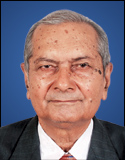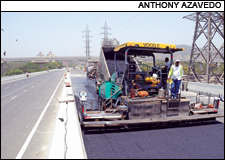 — Prof. B.B. Pandey, Advisor – Sponsored Research and Industrial consultancy, IIT Kharagpur
— Prof. B.B. Pandey, Advisor – Sponsored Research and Industrial consultancy, IIT Kharagpur
Dr. B.B. Pandey, who has been associated with IIT Kharagpur since 1964, has developed a new technology for maintenance-free rural roads using recycled plastic and an ‘in-vehicle falling weight Deflectometer’ for evaluation of strength of Highways. In this interview with Lalitha Rao, he discusses the state of roads and highways in India and how technology can improve their quality and durability.
Are you satisfied with the current technology used in Indian road construction?
The technology used in India is almost the same as that practiced in developed countries. Many roads in India are constructed without any regard to the quality. Most road builders do not know or do not want to know the finer points of road construction.
Quality control is sacrificed in India in most roads. In USA, quality control tests are done both in contractors’ as well as the government’s laboratory and if the two results are in agreement, the work is accepted. Government’s laboratories in USA have state-of-the-art equipment and laboratory staff appears to be very knowledgeable, as found during my interactions with them.
Our government laboratories in different states are ill equipped and few have the expertise and familiarity with complex nature of tests that are needed for quality control even though the project cost is very high. That is one of the reasons that many of our state and district roads are damaged within two years of the construction as against minimum of five to 10 years of maintenance-free life for a newly constructed road surface in Europe and USA.
There is much hue and cry about the fixing of IPL matches, but there is hardly any commotion when a new road fails in India. Nobody is held accountable. There is no enquiry also.
 In spite of having national standards, why does the quality of national highways differ from state to state?
In spite of having national standards, why does the quality of national highways differ from state to state?
Leaving aside tolled four- and six-lane national highways built and maintained by private concessionaires to an acceptable standard, other national highways passing through different states are looked after by the respective states. Level of expertise varies greatly from state to state and engineers in some states are a little more knowledgeable. No record of performance of roads is maintained and little effort is made to try different methods to get rid of recurring defects that develop during the service. Hardly new trials are made to develop better specifications. There are a few individuals in every state who are knowledgeable and they have a burning desire to do a good job given the freedom by the seniors in the government organisations.
Different states in India have different climate but practically the same specifications are adopted all over India. This is one of the reasons for widely different performance in different states. Performance of highways is continuously monitored in USA, in different states, and every state amends standards from time to time in light of the performance to suit the local climate. A large amount of fund is set aside by state governments in USA for practical research by universities so that students and faculty can actively participate in the solution of practical problems. Similar is the setup in other countries.
Such a system does not exist in India presently. Hopefully, things will change when right thinking daring officers take charge of the affairs of road infrastructure.
In a tropical country like India, which would you prefer – bituminous roads or concrete roads?
Both cement and bitumen industries employ lakhs and lakhs of people and both forms of roads have to be constructed. Properly built concrete roads are very durable though the initial cost is high. In localities where drainage is poor, bituminous roads get damaged in a short time while concrete roads survive. Bituminous roads are comfortable to drive due to much lower sound while a concrete road is very noisy. Drivers prefer well-made bituminous pavements
You have done research on maintenance-free rural roads using recycled plastic. Can you tell us more about it?
The technology consists of placing a formwork of cells of plastic strips over compacted soil, filling up the cells with concrete and compacting it with a plate vibrator. Alternatively, the cells are filled up with single size stone chips, compacted with a road roller and cement-sand-water slurry is applied over the compacted stone chips. The slurry fills up the void space between stone chips. Upon curing with water, a very strong road is formed which is practically maintenance free, the construction is labour intensive and local villagers are to be involved in cell making.
The technology was used about five years back in Karnataka, at Doddaballapur under Swarn Gram Yojana of the Panchayat Raj Engineering Department, Government of Karnataka. The technology was transferred to engineers of Madhya Pradesh, Jharkhand and Bihar. A road was constructed by IIT Kharagpur about eight years back in a village 10 km away and the road is still in good condition with zero maintenance. The cost was 50 per cent of a conventional road. Mizoram is going to adopt the technology in a big way.
What solutions do you have for potholed roads in the metros?A simple technique is now available for pothole repair in a short time. The area around the pothole is heated with LPG, the material is taken out, fresh bitumen is added to the same material along with some new aggregates, and the pothole area is refilled with hot bituminous mix and compacted. The pothole problem is thus fixed. Even when the road is wet, this method can be applied in metros. Cold bituminous mix using cut back or bitumen emulsion can be applied over other roads in dry periods.
| Key problems and solutions |
|
Education: If one wants to destabilise a country, destroy its educational system. Our educational system is in shambles. Even in IITs, the students coming from better families lack ethics. Possibly, schools do not teach character building so that students take to righteous path in future. Masses do not have access to education. Lack of education and extreme poverty are root cause of many ills of rural society. They become victims of unsocial elements and commit crimes for a small reward. A good education is a must if we want to develop into a civilised society. Our school education should emphasise on character building. Teachers have to be paid very high salaries. Unless there is missionary zeal on the part of all involved with flowering boys and girls, we cannot produce great souls in numbers. Teachers should demonstrate, by examples, different scientific experiments in the elementary class itself to generate curiosity in students at an early age. I was fortunate to have been taught science by a teacher in a very average school in Patna who demonstrated scientific experiments in class VIII in 1951. Nowadays it is not happening in most schools. Research: Barring a few exceptions, the aim of most research in academics is to get doctorate degrees and paper publications in order to get quick promotion for the faculty and a good job for the scholar .Most of the problems are theory based and scholars do get good training. Good investment in the form of scholarship and some additional grant is made in research in science and technology but the outcome is a doctorate thesis and published papers. The country does not benefit directly in terms of new products capable of generating wealth for the country. The Chinese are able to produce wealth because of their focus on applied research. We are not doing much because of lack of direction on the part of funding or user organisations. Good amount of funds should be spent in time bound basic and applied research with positive outcome in mind so that the country becomes rich. Our import bill is too high compared to export. Now we are buying plenty of equipment from China in spite of having a large number of technical and scientific manpower. Talent: India is not living up to its potential. There is plenty of talent in India. When a scientist goes to US or Europe, he does wonders. We are unable to use our talent. IIT graduates as well as those from NITs and other toppers in science and technology in different universities possess enough brain power and have the capability to lead the country in science and technology but they end up in marketing, banking, management because of attraction of money and glare. Many others who do not get prestigious jobs like those in civil services or paying jobs in private sector end up in research and teaching. It is not difficult to guess why DRDO is not able to produce quality tanks and other gadgets for warfare. Developed countries including China have gone far ahead in this direction. My laboratory, also, has purchased Chinese equipment and it is working fine. Law enforcement: Law enforcement is practically nil. Only a fraction of the cases come under the net of the law enforcing agency. Overloading on trucks on roads is to be regulated by motor vehicle department but it is not done in spite of Supreme Court’s directive for the enforcement of the law of the land regarding legal axle load limits of trucks. Roads are damaged in a short time. Huge sum of money invested in the road is lost. Government policy: Our policy is good, but its implementation has to be done very strictly. Senior students of schools/and colleges may be involved in a big way in developmental programmes of the government in rural areas, since they are still free from many vices. This sort of activity can be a part of the curriculum. Bookish knowledge alone without any purpose is ruining us. Farm production: Agriculture production is not showing much growth. Agricultural research is not making a wide impact. Some areas in Bihar which I visited show very low yield. Huge amount of groundwater is wasted in irrigation. Year after year, increasing amount of fertilisers is being used to maintain the yield. Quality of groundwater is going to be effected. Many areas on the banks of the Ganga in Bhojpur district of Bihar have underground water polluted with arsenic. |
Tell us about your invention – weight deflectometer?
Falling Weight deflectometer (FWD) is not my invention. I developed one with the help of students after working on it over a period of six years. Its price in the international market is too high to be affordable by most consultancy and government organisation. The equipment consists of applying an impact load on a road and the deformed profile of the measured. From the impact load and the deformed profile, different layers of a road can be evaluated for its strength without damaging the road. The technology of FWD was transferred to an Indian company who has started manufacturing and selling at 25 per cent of the price of the imported equipment.
So, where does India stand today? Which direction is it headed?
Add to the above answers touching on these issues, the economic slowdown worldwide, on one hand, and subdued market sentiment, lack of political will, policy and reform paralysis, and infrastructure stagnation in India, on the other.











